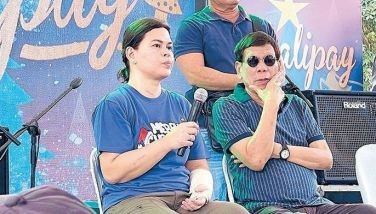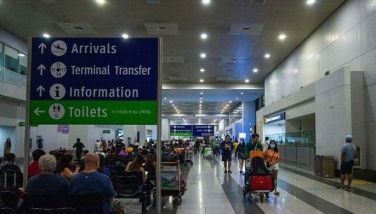Survivors, kin of victims still await justice 19 years after Mendiola massacre
January 23, 2006 | 12:00am
Nineteen years after the Mendiola Massacre, survivors, family and relatives of the victims are wondering where lady justice went and why she has remained elusive as ever.
Yesterday, they took to the streets again and assembled at the Bantayog ng mga Bayani in Quezon City for a prayer rally and question for the ages: "How Long Will We Wait for Justice to Be Served?"
Letty Arjona-Arias, sister of Danilo Arjona, a farmer from Laguna who was among the casualties of the infamous incident, lamented that the case was far from being resolved.
"Thirteen lives ended in that massacre. Yet nothing was done to resolve the case. It is as if the lives of those 13 peasants were of no value, they don’t deserve any concern at all from the government," she said.
Donned in black dresses and headdresses signifying their continued mourning, the widows and other loved ones left behind vowed to pursue the fight until justice is served.
During the simple commemoration of the 19th anniversary of the Mendiola Massacre, sugar farm-workers of Hacienda Luisita arrived to sympathize with the massacre victims’ families and relatives, as well as peasants from Palo, Leyte, where another alleged massacre of farmers by elements of the military took place last year.
On Jan. 22, 1987, anti-riot teams from then Western Police District (WPD), the Integrated National Police (INP) and Philippine Marines opened fire on a protest-rally of some 10,000 farmers who were demanding genuine land reform.
After the smoke cleared, 13 farmers identified as Danilo Arjona, Dante Evangelio, Angelito Gutierrez, Leopoldo Alonzo, Dionisio Bautista, Roberto Caylao, Adelfa Aribe, Vicente Campomanes, Rodrigo Grampan, Ronilo Dumanico, Bernabe Laquindanum, Roberto Yumul, and Sonny Boy Perez, were already dead.
At least 80 farmers were injured. The victims were members of the militant Kilusang Magbubukid ng Pilipinas (KMP).
According to the KMP, peasants and fisherfolk camped out in front of the then Ministry of Agrarian Reform in Quezon City on Jan. 15, 1987 and clamored for the fulfillment of the Comprehensive Agrarian Reform Program (CARP), as promised by then President Corazon Aquino.
On Jan. 20, 1987, KMP leaders led by Jaime Tadeo held a dialogue with then Agrarian Reform Minister Heherson Alvarez. The dialogue, however, collapsed, which eventually led farmers to decide to march towards Malacañang on Jan. 22, 1987 in order to present their demands directly to Mrs. Aquino.
The KMP said the gunshots rang out after marchers managed to breach the police line. But even before this, the farmers group claimed that there was an explosion and the hurling of pillboxes, stones, and bottles as demonstrators tried to break the blockade of anti-riot teams at the foot of Mendiola Bridge.
The KMP also said that even after the rallyists dispersed, sporadic firing went on.
After the incident, President Aquino ordered the creation of the Citizens’ Mendiola Commission headed by retired Supreme Court Justice Pedro Abad Santos.
The commission, on Feb. 27, 1987, recommended the criminal prosecution of four unidentified, uniformed individuals shown either on film footage or in photographs firing in the direction of the marchers.
It also recommended the prosecution of all the commissioned officers of the police’s anti-riot squad, who were armed during the incident.
On Feb. 10, 1988, the House Committee on Human Rights recommended the expeditious payment of compensation to the victims.
For their part, the survivors and victim’s families filed a class suit against the government and certain police and military officers for damages totaling some P6.5 million.
Among the defendants were former President Fidel Ramos, who was then Defense secretary; former Armed Forces chief Gen. Renato De Villa; Sen. Rodolfo Biazon, who was then chief of the Philippine Marines; and former Philippine National Police chief Cesar Nazareno, who was then deputy superintendent of the WPD.
But on May 31, 1988, the Manila regional trial court dismissed the class suit and on Aug. 8, 1988, the Supreme Court upheld the lower court’s decision, citing government’s immunity from suit.
KMP’s information officer Carl Ala said that to date, the victims have not received any compensation while no one has ever been indicted for the incident.
Yesterday, they took to the streets again and assembled at the Bantayog ng mga Bayani in Quezon City for a prayer rally and question for the ages: "How Long Will We Wait for Justice to Be Served?"
Letty Arjona-Arias, sister of Danilo Arjona, a farmer from Laguna who was among the casualties of the infamous incident, lamented that the case was far from being resolved.
"Thirteen lives ended in that massacre. Yet nothing was done to resolve the case. It is as if the lives of those 13 peasants were of no value, they don’t deserve any concern at all from the government," she said.
Donned in black dresses and headdresses signifying their continued mourning, the widows and other loved ones left behind vowed to pursue the fight until justice is served.
During the simple commemoration of the 19th anniversary of the Mendiola Massacre, sugar farm-workers of Hacienda Luisita arrived to sympathize with the massacre victims’ families and relatives, as well as peasants from Palo, Leyte, where another alleged massacre of farmers by elements of the military took place last year.
On Jan. 22, 1987, anti-riot teams from then Western Police District (WPD), the Integrated National Police (INP) and Philippine Marines opened fire on a protest-rally of some 10,000 farmers who were demanding genuine land reform.
After the smoke cleared, 13 farmers identified as Danilo Arjona, Dante Evangelio, Angelito Gutierrez, Leopoldo Alonzo, Dionisio Bautista, Roberto Caylao, Adelfa Aribe, Vicente Campomanes, Rodrigo Grampan, Ronilo Dumanico, Bernabe Laquindanum, Roberto Yumul, and Sonny Boy Perez, were already dead.
At least 80 farmers were injured. The victims were members of the militant Kilusang Magbubukid ng Pilipinas (KMP).
According to the KMP, peasants and fisherfolk camped out in front of the then Ministry of Agrarian Reform in Quezon City on Jan. 15, 1987 and clamored for the fulfillment of the Comprehensive Agrarian Reform Program (CARP), as promised by then President Corazon Aquino.
On Jan. 20, 1987, KMP leaders led by Jaime Tadeo held a dialogue with then Agrarian Reform Minister Heherson Alvarez. The dialogue, however, collapsed, which eventually led farmers to decide to march towards Malacañang on Jan. 22, 1987 in order to present their demands directly to Mrs. Aquino.
The KMP said the gunshots rang out after marchers managed to breach the police line. But even before this, the farmers group claimed that there was an explosion and the hurling of pillboxes, stones, and bottles as demonstrators tried to break the blockade of anti-riot teams at the foot of Mendiola Bridge.
The KMP also said that even after the rallyists dispersed, sporadic firing went on.
After the incident, President Aquino ordered the creation of the Citizens’ Mendiola Commission headed by retired Supreme Court Justice Pedro Abad Santos.
The commission, on Feb. 27, 1987, recommended the criminal prosecution of four unidentified, uniformed individuals shown either on film footage or in photographs firing in the direction of the marchers.
It also recommended the prosecution of all the commissioned officers of the police’s anti-riot squad, who were armed during the incident.
On Feb. 10, 1988, the House Committee on Human Rights recommended the expeditious payment of compensation to the victims.
For their part, the survivors and victim’s families filed a class suit against the government and certain police and military officers for damages totaling some P6.5 million.
Among the defendants were former President Fidel Ramos, who was then Defense secretary; former Armed Forces chief Gen. Renato De Villa; Sen. Rodolfo Biazon, who was then chief of the Philippine Marines; and former Philippine National Police chief Cesar Nazareno, who was then deputy superintendent of the WPD.
But on May 31, 1988, the Manila regional trial court dismissed the class suit and on Aug. 8, 1988, the Supreme Court upheld the lower court’s decision, citing government’s immunity from suit.
KMP’s information officer Carl Ala said that to date, the victims have not received any compensation while no one has ever been indicted for the incident.
BrandSpace Articles
<
>
- Latest
- Trending
Trending
Latest
Trending
Latest
Recommended































